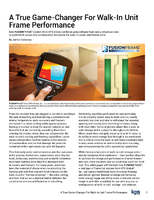Ball Aerospace OMPS Instrument Delivers 2012 Ozone Measurements
Share:

BOULDER, Colo. - Ball Aerospace & Technologies Corp.'s Ozone and Mapping Profiler Suite (OMPS) has made its first ozone measurements of the Antarctic ozone hole since launching aboard NASA's Suomi National Polar-orbiting Partnership (NPP) satellite on Oct. 28, 2011.
According to NASA and NOAA, the 2012 satellite measurement map of the Antarctic ozone hole shows that it is the second-smallest in 20 years since it appeared in the early 1980s. This is the first year Ball's OMPS instrument is providing the ozone data, continuing a satellite record dating from the early 1970s.
Under contract to NASA, Ball Aerospace designed and built OMPS and the Suomi NPP satellite, and integrated all five of the satellite's instruments. Suomi NPP orbits Earth every 102 minutes, and to date has completed 5,000 orbits capturing data from the Earth's land, oceans and atmosphere. Currently Ball is building Suomi NPP's successor, the Joint Polar Satellite System-1 (JPSS-1) satellite and its OMPS instrument, to maintain continuity of weather and environmental observations into the 2030s by providing a daily map of the entire globe's ozone.
"Science and society are greatly benefitting from the successful delivery of data from the new set of instruments aboard Suomi NPP as it prepares our nation for the next-generation of polar-orbiting weather satellites," said David L. Taylor, Ball Aerospace president and CEO. "Suomi NPP and JPSS-1 allow more accurate global environmental predictions and improve weather forecasts for millions of people."
Ball's OMPS instrument measures atmospheric ozone and how ozone concentration varies with altitude. The three-part instrument includes a nadir profiler, to help scientists better understand ozone destruction in the middle and upper stratosphere; a limb profiler, to discern lower stratospheric ozone variations; and a nadir mapper to analyze daily global total ozone maps. Ball's OMPS is based on its previous instrument, the Solar Backscatter Ultraviolet instrument (SBUV/2).
This year's Antarctic ozone hole size reduction is attributed to warmer conditions over that continent. The average size of the 2012 ozone hole was 6.9 million square miles, compared to 11.5 million square miles in 2000. Even though it is smaller than in years past, the ozone layer above Antarctica is not expected to return to its early 1980s state until about 2065. The NASA/NOAA collection of ozone data contributes to fulfilling the monitoring requirements of the Montreal Protocol, a 1989 international treaty.
Ball Aerospace & Technologies Corp. supports critical missions for national agencies such as the Department of Defense, NASA, NOAA and other U.S. government and commercial entities. The company develops and manufactures spacecraft, advanced instruments and sensors, components, data exploitation systems and RF solutions for strategic, tactical and scientific applications. For more information visit www.ballaerospace.com.
Ball Corporation (NYSE:BLL) is a supplier of high quality packaging for beverage, food and household products customers, and of aerospace and other technologies and services, primarily for the U.S. government. Ball Corporation and its subsidiaries employ more than 14,500 people worldwide and reported 2011 sales of more than $8.6 billion. For the latest Ball news and for other company information, please visit www.ball.com.
SOURCE Ball Aerospace & Technologies Corp.
CONTACT: Roz Brown, +1-303-533-6059, rbrown@ball.com
Web Site: www.ballaerospace.com




